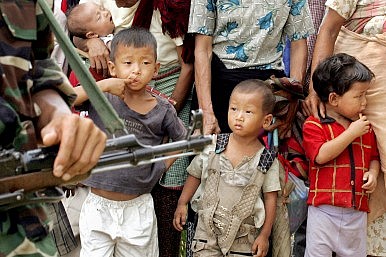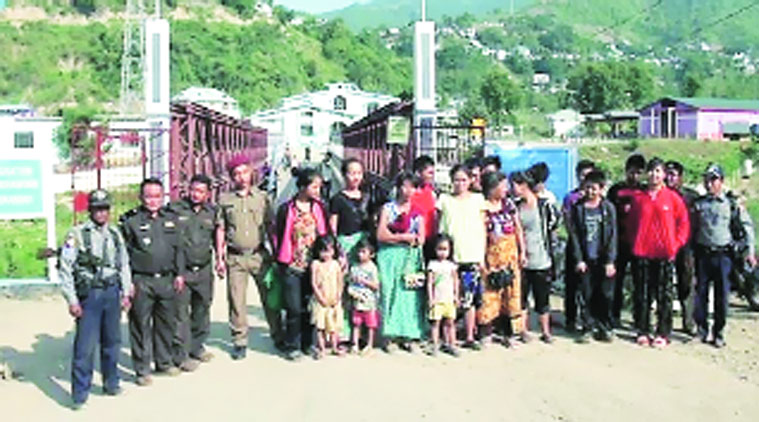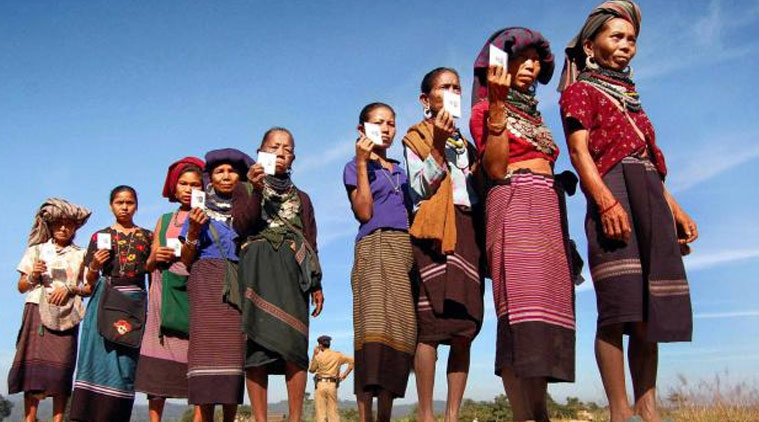
Image Credit: REUTERS/Adnan Abidi
Ever
since Independence, peace and stability have been treasured luxuries in
the Indian states of Nagaland and Manipur. In the last two decades,
however, while peace talks may have produced little in the way of
progress, ceasefire agreements with the various warring groups have at
least provided a relative peace.The Naga issue is the major threat to peace in India’s Northeast. Broadly speaking, the insurgent groups National Socialist Council of Nagaland – Khaplang (NSCN-K) and the National Socialist Council of Nagaland – Isak Muivah (NSCN-IM), which claim to represent the Nagas, demand that a territory known as Nagalim (or Greater Nagaland) – which would include the present state of Nagaland along with roughly four districts of Manipur and parts of Assam and Arunachal Pradesh where Nagas live – be carved out to address the Naga issue. The proposed region of Nagalim would also include a not insignificant chunk of Myanmar, making this an international issue.
Fifteen years back the Indian government agreed to a ceasefire with the two major Naga insurgent groups, and both sides called for solutions through negotiations. Unfortunately, nothing worthwhile was achieved, except the routine extension of the ceasefire. Then, in an unprecedented move, the Myanmar-based S.S. Khaplang faction of NSCN, NSCN-K unilaterally withdrew from the ceasefire on March 27. This move will have far-reaching repercussions for the local population. Once again, it seems, Nagaland is on the verge of a nasty bloodbath. In the last 14 years, with the NSCN-IM and NSCN-K observing ceasefires with the government, the Nagas have become accustomed to relative peace. Now the future appears uncertain.
This was brought home by an attack last month on Assam Rifles personnel in the Mon district of Nagaland, in which eight soldiers were killed by NSCN-K cadres. The attack underscores the political uncertainty and associated risk of violence in a region that otherwise has immense potential for development.
On close observation, there are three primary reasons for this move by the Khaplang faction of NSCN.
Loss of Public Support
First, over the years during which the ceasefire agreements held, the insurgent groups in Nagaland increasingly lost the public support they once enjoyed. Violence has given way to comparative peace and locals are realizing (even if slowly) that their grievances will not be solved through the barrel of a gun. The younger generation no longer has the same sympathy towards the insurgent groups that their parents did. They have been witness to development. Many have been exposed to life in cities like Delhi, Bangalore, Pune, and Kolkata. They have seen the possibilities the big cities offer. They have seen their counterparts elsewhere in India prosper and so are now more inclined to seek to make a living by hard work rather than by taking up arms. The floating population has also exposed those back home to the prospects of the cities, and this to a great extent has redefined their understanding of development. The message is clear, at least among youth, that violence is now a failed strategy.
Moreover, the ideology of the Naga leaders has stagnated. It has not evolved with the times. There is nothing new in their proposed glorious future nor is there anything fresh in their strategy to attain it. Put simply, Naga leaders are failing to capture the imagination of the present generation. This is an issue explored in a recent report in Nagaland Post – a leading daily from Nagaland – which appeared in the wake of the May 3 killings.
In a bid to make its presence felt in the Naga community and save itself from extinction, the Khaplang faction has ventured back onto the path of violence. But while the ceasefire agreement had its drawbacks, it at least ensured that no lives were lost.
Sidelined
Second, there was a general apprehension within the Khaplang faction that New Delhi is systematically sidelining it from the Naga talks. There is considerable merit in this apprehension. In fact, when the ceasefire was first announced it was with NSCN-IM, and not with NSCN-K. It was only later, following violent protests in Manipur and other regions, that the ceasefire was extended to NSCN-K. Throughout the talks on the Naga issue New Delhi in one way or the other has considered the Muhiva faction NSCN-IM to be the “genuine” representative of the Nagas. This is largely because NSCN-K is seen to have its stronghold in the Naga-dominated areas of Myanmar rather than in India.
Evidence of New Delhi’s indifference towards the Khaplang faction can be gauged from the Uninion Minister of State for Home Minister (GOI), Kiren Rijju’s statement in parliament. In a written reply Rijju said, “NSCN-K has walked out from the dialogue process with GOI. NSCN-K with its Myanmar based leadership is mainly interested in extortion and has nothing to do with Naga issues.” He added that “security forces would react accordingly” in response to the May 3 attack by NSCN-K and that “talks with NSCN (I-M) for settlements are continuing and interlocutor has been appointed for the purpose.”
This proximity of New Delhi to the Muhiva faction has made Khaplang prudent about its own position. Thus moving out of the ceasefire agreement at present provides the Khaplang faction with a chance to reposition itself in the Naga talks.
Infighting
Third, the Khaplang group has lately been troubled by ongoing infighting within its own ranks. Of late there has emerged a clutch of leading figures (among them Wangtin Naga, P Tikhak, and Wanglon Konyak) have favored peace talks with New Delhi and even diluting the group’s staunch demand of a separate Naga homeland. This, they believed, is a more realistic approach at the moment. However, Khaplang thinks otherwise and believes that any talk with India cannot undermine the principle of sovereignty of the Naga people. It is thus not surprising that the day NSCN-K walked away from the ceasefire agreements these rebel leaders themselves walked out of the group and formed one of their own called National Socialist Council of Nagaland – Reformation. Within days NSCN-R had signed a ceasefire agreement with the Indian government.
It is clear that the recent moves by the Khaplang faction are part of an effort to answer its own existential question and reposition itself within Naga politics. But this effort also jeopardizes the lives and liberty of the local population.
These developments in the Northeast have far-reaching implications for the stability of the region. It also clouds the future of India’s ambitious “Act East” policy, which aims to deepen trade relations with Southeast Asia. India cannot enjoy a healthy trade relationship with this part of Asia if it does not have a peaceful Northeast.
Further complicating the issues is the fact that NSCN-K has signed ceasefire agreements with the Myanmar government and that the Nagas have been accorded autonomous status in certain regions. Writing for the Indian Express Sanjib Batuah observed, “Increasingly, the Indian approach to the Naga conflict is at odds with developments across the border. The ceasefire between the government of India and the S.S. Khaplang-led faction of the NSCN has unraveled and there have been attacks on Indian soldiers by NSCN-K militants. But across the border, relations between Khaplang and the Myanmar government have been on the upswing. The group has signed a five-point agreement with the Thein Sein government. The terms include a ceasefire, the opening of a liaison office to facilitate talks and freedom of movement for unarmed cadres within Myanmar.”
The six-decade history of the Naga issue suggests that violence has done more harm than good. While peace talks are the only rational solution, New Delhi must realize that by sidelining a faction of the NSCN in the talks, it is only perpetuating the chaos and breeding future resentment.
New Delhi also urgently needs to boost its ties with Myanmar, not only in terms of trade relations but also to help it resolve the Naga issue, which troubles both countries. While Myanmar has been able to handle its problem with the Nagas quite well (mainly by according them autonomous status and entering into ceasefire agreements), India has allowed the issue to drag on for six decades. Nor is there any resolution in sight.
An early solution to the Nagas is in everyone’s interests. Only when peace is ensured can development can take place. The hills of Nagaland and Manipur will echo with bullets as long as the leaders continue to embroil local communities in their ambitious projects. It is time now for these same communities to make themselves the architects of their own future – a future that should be marked by stability, development, and peace.
Mukesh Rawat is a freelance journalist based in New Delhi and has spent seven years in various regions of Northeast India. mukeshrawat705@gmail.com Twitter: @mukeshrawat705














